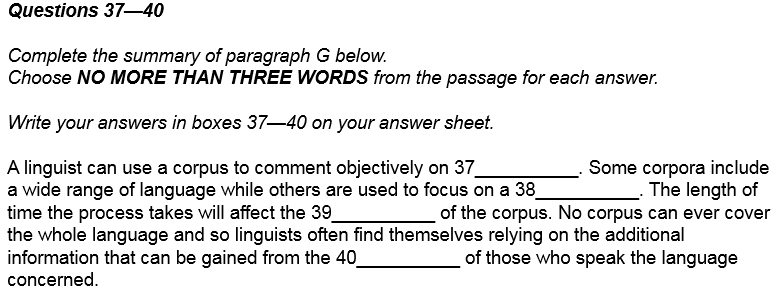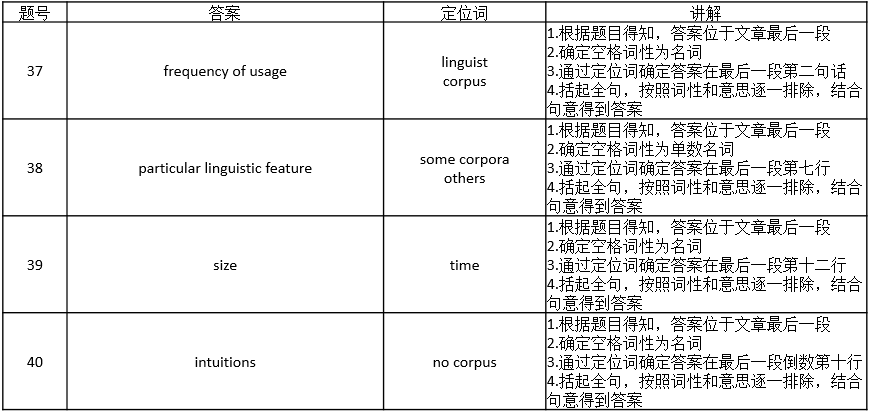【小站课堂】雅思阅读摘要题讲解--Obtaining Linguistic Data
- 2016年09月28日14:39 来源:小站教育作者:小站雅思编辑
- 参与(6) 阅读(33418)
小站独家,雅思阅读机经真题解析。一切患有雅思阅读刷题强迫症的烤鸭,请看这里。小站精心整理了一批雅思阅读机经真题。如果你的剑桥雅思阅读已是烂熟于心,那么这一系列的雅思阅读机经真题真的很适合你,搭配上绝对原创的讲解,还有全文的中文翻译,这等阅读大餐,还等什么!
Obtaining Linguistic Data
A
Many procedures are available for obtaining data about a language. They range from a carefully planned, intensive field investigation in a foreign country to a casual introspection about one's mother tongue carried out in an armchair at home.
B
In all cases, someone has to act as a source of language data — an informant. Informants are (ideally) native speakers of a language, who provide utterances for analysis and other kinds of information about the language (e.g. translations, comments about correctness, or judgments on usage). Often, when studying their mother tongue, linguists act as their own informants, judging the ambiguity, acceptability, or other properties of utterances against their own intuitions. The convenience of this approach makes it widely used, and it is considered the norm in the generative approach to linguistics. But a linguist’s personal judgments are often uncertain, or disagree with the judgments of other linguists, at which point recourse is needed to more objective methods of enquiry, using non-linguists as informants. The latter procedure is unavoidable when working on foreign languages, or child speech.
C
Many factors must be considered when selecting informants — whether one is working with single speakers (a common situation when languages have not been described before), two people interacting, small groups or large-scale samples. Age, sex, social background and other aspects of identity are important, as these factors are known to influence the kind of language used. The topic of conversation and the characteristics of the social setting (e.g. the level of formality) are also highly relevant, as are the personal qualities of the informants (e.g. their fluency and consistency). For larger studies, scrupulous attention has been paid to the sampling theory employed, and in all cases, decisions have to be made about the best investigative techniques to use.
D
Today, researchers often tape-record informants. This enables the linguist’s claims about the language to be checked, and provides a way of making those claims more accurate (‘difficult’pieces of speech can be listened to repeatedly). But obtaining naturalistic, good-quality data is never easy. People talk abnormally when they know they are being recorded, and sound quality can be poor. A variety of tape-recording procedures have thus been devised to minimize the ‘observer’s paradox’ (how to observe the way people behave when they are not being observed). Some recordings are made without the speakers being aware of the fact — a procedure that obtains very natural data, though ethical objections must be anticipated. Alternatively, attempts can be made to make the speaker forget about the recording, such as keeping the tape recorder out of sight, or using radio microphones. A useful technique is to introduce a topic that quickly involves the speaker, and stimulates a natural language style (e.g. asking older informants about how times have changed in their locality).
E
An audio tape recording does not solve all the linguist’s problems, however. Speech is often unclear and ambiguous. Where possible, therefore, the recording has to be supplemented by the observer’s written comments on the non-verbal behavior of the participants, and about the context in general. A facial expression, for example, can dramatically alter the meaning of what is-said. Video recordings avoid these problems to a large extent, but even they have limitations (the camera cannot be everywhere), and transcriptions always benefit from any additional commentary provided by an observer.
F Linguists also make great use of structured sessions, in which they systematically ask
their informants for utterances that describe certain actions, objects or behavior. With a bilingual informant, or through use of an interpreter, it is possible to use translation techniques (‘How do you say table in your language?’). A large number of points can be covered in a short time, using interview worksheets and questionnaires. Often, the researcher wishes to obtain information about just a single variable, in which case a restricted set of questions may be used: a particular feature of pronunciation, for example, can be elicited by asking the informant to say a restricted set of words. There are also several direct methods of elicitation, such as asking informants to fill in the blanks in a substitution frame (e.g. I ___ see a car), or feeding them the wrong stimulus for correction (‘Is it possible to say I no can see?’).
G A representative sample of language, compiled for the purpose of linguistic analysis,
is known as a corpus. A corpus enables the linguist to make unbiased statements about frequency of usage, and it provides accessible data for the use of different researchers. Its range and size are variable. Some corpora attempt to cover the language as a whole, taking extracts from many kinds of text; others are extremely selective, providing a collection of material that deals only with a particular linguistic feature. The size of the corpus depends on practical factors, such as the time available to collect, process and store the data: it can take up to several hours to provide an accurate transcription of a few minutes of speech. Sometimes a small sample of data will be enough to decide a linguistic hypothesis; by contrast, corpora in major research projects can total millions of words. An important principle is that all corpora, whatever their size, are inevitably limited in their coverage, and always need to be supplemented by data derived from the intuitions of native speakers of the language, through either introspection or experimentation.
真题讲解:
长难句练习:
1. But a linguist’s personal judgements are often uncertain, or disagree with the judgements of other linguists, at which point resource is needed to more object methods of enquiry (询问), using non-linguists as informants.
参考译文:然而,一名语言学家的个人判断通常是不确定的,或者是与其他的语言学家意见不同,此时,就需要更加客观的询问方式,让非语言学家来充当资料提供者。
语法点:point的用法:at the point of正在……的时候; come to the point 谈到正题;have one’s point 有独到之处;up to point在一定程度,有一点
2. Video recordings avoid these problems to a large extent, but even they have limitations (the camera cannot be everywhere), and transcription always benefits from any additional commentary provided by an observer.
参考译文:录像方式在很大程度上可以避免这样的问题,但是就算是这个方式也存在局限性(摄像机不可能安得到处都是),而且文字誊本总是要得益于观察者另外提供的注解。
语言点:benefit的用法:益处、好处;义演、义卖
3. An important principle is that all corpora, whatever their size, are inevitably limited in their coverage, and always need to be supplemented by data derived from the intuitions of native speakers of the language, though either introspection or experimentation.
参考译文:一个重要的原则是,无论大小,所有的语料库在覆盖面上都不可避免的存在局限性,因此,他们就总是需要通过内省或实验的方式,被源自母语者的直觉的资料补充。
语言点:principle是主语,is是系动词,that引导表语从句,whatever their size是插入语。表语从句的主语是all corpora;谓语是are limited,need to be supplemented;derived是过去分词作定语来修饰data; through引导的是状语。













































